Building and servicing above-ground pools
by Sally Bouorm | August 1, 2014 12:25 pm
 [1]
[1]Editor’s note: Today’s above-ground swimming pools are no longer just for the price-sensitive market, as they are being sold as an architectural feature in the backyard. Although they can be much easier to install and maintain when compared to their inground pool counterparts, it is important that installers and service professionals follow a series of best practices when it comes to above-ground pool installation and winterization procedures. That said, Pool & Spa Marketing asked Mermaid Pools and Hot Tubs, a large retailer and installer of above-ground pools in the Ottawa and Gatineau, Que., regions, to share some of its techniques, which have proven to be successful. The technical procedures discussed in this article are those of Mermaid Pools and Hot Tubs and may not apply to every above-ground swimming pool installation/retail company.
By Brian Babb and Myrtle Myers
Mermaid Pools and Hot Tubs have trialed several above-ground swimming pool installation and winterization techniques since the company was established in 1965. This experience has provided the company with informed and unique perspectives on above-ground pool installation and service procedures that are still being used today. This article is not a step-by-step technical account of how the company installs its above-ground pools, but rather an opportunity to share some of the company’s best practices, observations, and lessons learned.
Pre-installation preparation
Pre-installation organization and preparedness are crucial for any pool company. In fact, project preparation is the most important aspect of ensuring a successful installation. As long as the homeowner follows the instructions in advance and the pool installers ensure proper levelling, drainage, base, and materials, the above-ground pool will be a safe, sturdy long-term investment, which the family can enjoy for many years.
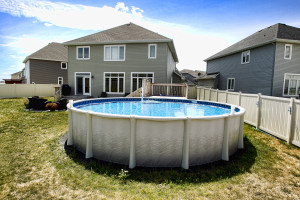 [2]
[2]The preparatory work, however, starts well before the installer arrives at the client’s home. It actually begins in the company’s delivery and installation departments, which plans and co-ordinates every project to ensure a smooth installation and a happy customer. Both departments should include expert delivery and installation personnel who are well versed in warehouse management, co-ordinating multiple deliveries throughout a large region, scheduling numerous installation crews, and understanding the company’s products and warranties. Staff in these departments also work behind the scenes to ensure above-ground pool installations go as planned.
Having an efficient delivery department helps facilitate the work of a company’s pool installers. For example, by delivering the above-ground pool kit in advance, the installer can start the project immediately upon arriving at the client’s home.
Equally as important is the information and customer service these departments offer. The installation department assists clients by preparing them prior to the start of a project so they know what to expect. And, should a client require assistance or have any questions or concerns, they can call the company directly, rather than the installer.
Another good idea is to use a comprehensive booking sheet in advance of the installation. This documentation provides all parties with important information to prepare for all eventualities. Not only is the booking sheet the company’s most important fact gathering tool, it can also help alleviate some of the client’s stress, which comes along with a new pool installation.
This documentation should contain all of the necessary information about the project (e.g. pool type, size, liner pattern, location of trees in the yard, ground conditions, etc.), which is obtained via a site inspection and/or from the customer over the phone. When everything is said and done, the booking sheet is then e-mailed to the client.
Another benefit of using a booking sheet as part of pre-installation best practices is it can be a helpful resource when educating the client about the installation process and what they are responsible for. For example, it will inform them about getting a pool enclosure permit, as well as finding and scheduling a water truck and electrician.
Avoid backfilling and decorative rocks
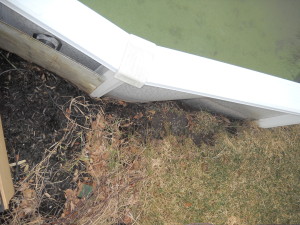 [3]
[3]Although various installers have different views on backfilling above-ground pools, this installation approach should generally be avoided. While some homeowners like the look of a backfilled pool, there are several reasons why this can be problematic.
In some cases, backfilling an above-ground pool can put too much pressure on the structure, which can damage the pool or even cause it to collapse. And, in some cases, it can also make the pool liner difficult to replace. Further, during the winter, water will collect around the outside perimeter of a backfilled pool when instead it should drain away from this area.
In terms of a pool owner protecting his/her investment, an above-ground pool, which has been backfilled will, in some cases, void the manufacturer’s warranty as well as any insurance claims.
Decorative rocks or stonework installed around the perimeter of an above-ground pool can also cause drainage issues. Although these features are esthetically pleasing and can prevent weeds from growing around the pool, they are better suited for warmer climates. With the harsh winters experienced in this region, the rain in the fall accumulates under and around these rocks/stones. Once this water freezes, it can damage the bottom track of the pool as it will lock the track to the ground and, when the frost shifts, the pool will move with it causing severe damage. The pool structure can be likened to the foundation of a house; water should be encouraged to flow away from the pool, not gather around it.
Decks in relation to above-ground pools
A homeowner planning where their above-ground pool will be installed in relation to their deck is critical. For instance, there have been many cases where a simple deck has made the difference in a perfectly installed above-ground pool lasting several years or only a single season.
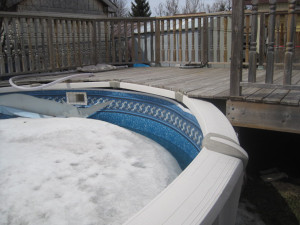 [4]
[4]Again, due to the harsh winter climate in some regions of Canada, the pool should not have any contact with the deck. The desire of many homeowners to eliminate these gaps (between the pool and deck) has seen many above-ground pools fall victim to shifting decks.
Above-ground pools should be installed no closer than 76 m (3 in.) to a deck and only experienced contract deck builders should build them when in proximity to these pools.
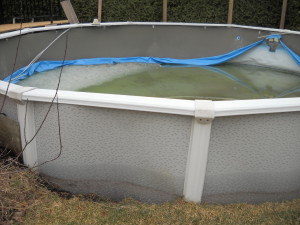 [5]
[5]Should an installer not follow these best practices, and the pool and deck are touching, when the ground begins to shift, the pool will ultimately lose the battle. The deck should not overhang the pool’s top rail, either. Almost every spring, above-ground pool installers receive photos of damaged pools from baffled homeowners where in most cases the deck is determined to be the culprit. This is easily determined by looking at the opposite end of the pool structure for signs of buckling.
Therefore, during the winterization process, the homeowner needs to ensure anything that is overhanging the deck, e.g. ladder or steps, is removed. When the ground shifts, there should be no contact between any part of the deck and pool. This will save the pool owner a lot of grief come spring.
Forward thinking
To be successful, a business must always be willing to test new technologies and/or procedures, which may have the potential to make their above-ground pool installations more durable, long lasting, and inexpensive. Two of the most important are liner guards and bonding.
Liner guards
The use of a geotextile liner guard—an extremely durable material that when used in association with soil has the ability to reinforce and protect—as part of an above-ground pool installation, eliminates pool liner damage caused by tree roots, ants and worms, as well as stones that can push through the sand base as a result of the freeze-thaw cycle. Prior to the availability of this technology, many installers used foam to protect pool liners; however, sometimes when dismantling these pools years later, installers discovered unevenness in the foam.
Not all clients understand the benefits of a liner guard and decide to have the pool installed without one; however, protecting the pool liner from the outside is important as it can save the client money by reducing the frequency of liner replacements. As an added benefit, a liner guard also creates a smoother pool floor, as opposed to using foam, which makes for easier vacuuming and pool cleaning.
Bonding the pool
For saltwater above-ground pool installations, incorporating a useful copper bonding (grounding) wire makes it much easier for the electrician to bond the salt system to metal components, such as the pool walls and skimmer screws. This procedure is in the pool owner’s best interest as not only does it help to prevent electrolysis from the salt chlorinator causing corrosion of metal parts, but it is also an important measure for bather safety.
Further, customers who purchase a salt chlorination system are required by most retailers to have their pools bonded by a certified electrician in order for the manufacturer to honour the warranty.
Do not forget about winterizing techniques
Just as it is important to be well-prepared for a successful installation, proper pool closing procedures in the fall are also vital to ensuring the client’s above-ground pool weathers the elements and stands the test of time.
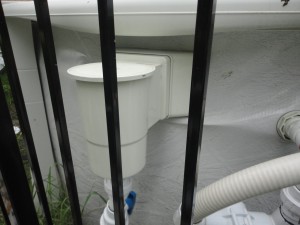 [6]
[6]There are a number of simple measures one can take to ready an above-ground pool for the long, frigid winter months that are experienced in areas such as the Outaouais region in western Quebec. Many in this region might think snow and ice are the biggest causes of above-ground pool damage and/or collapse; however, in reality, the number one reason is failing to winterize the pool properly.
In addition to water maintenance procedures (i.e. testing water parameters, shocking, and lowering the water level), along with removing any physical accessories (i.e. ladders, chemical feeders, skimmer basket, etc.), and draining water from equipment (i.e. pump, filter, and heater), attention to leaks, correct skimmer preparation, and the use of a winter cover are also strongly encouraged.
Leaky liners
Prior to winterizing the pool, companies should emphasize with their customers the importance of keeping a watchful eye for any leaks before the winter freeze.
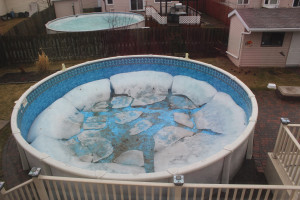 [7]
[7]If a leak is found, the pool owner should call their installer/local pool company immediately. If an above-ground pool loses water throughout the winter, the ice ‘cake,’ which forms at the water surface can drop and damage the liner and pool structure. This is another major reason why above-ground pools are damaged in the Ottawa-Outaouais region.
Skimmer closing
It is extremely important that a foam kit, plug and/or faceplate cover is used to ready the skimmer for the winter. These accessories, which fit into or attach to the face of the skimmer, prevent ice from bridging and causing severe damage to the pool. By not using one of these kits water will eventually enter the skimmer and freeze, connecting (bridging) the skimmer with the surface layer of ice, which forms in the pool. Ice bridging can damage both the skimmer and metal wall as the layer of ice in the pool will often rise and shift with snow, ice, and rain throughout the winter season.
The winter cover
The winter cover is the final step in the winterizing regimen. These covers are typically made of laminated polyethylene and come in various strengths. Most covers on the market today only provide a 1- to 1.2-m (3- to 4-ft) overlap; however, a 1.8-m (6-ft) overlap is recommended. The additional overlap allows the cover to float on the water loosely rather than being tight around the pool frame, which causes unwanted strain on the pool structure.
 Brian Babb is the pool service manager for Mermaid Pools and Hot Tubs, which has locations in Gloucester and Nepean, Ont., as well as Gatineau, Que. Babb has been in the pool service industry for 15 years. He can be reached via e-mail at poolservice@mermaidpools.com[8].
Brian Babb is the pool service manager for Mermaid Pools and Hot Tubs, which has locations in Gloucester and Nepean, Ont., as well as Gatineau, Que. Babb has been in the pool service industry for 15 years. He can be reached via e-mail at poolservice@mermaidpools.com[8].
[9]
 Myrtle Myers oversees the above-ground department for Mermaid Pools and is the purchaser for pool related products. She has worked in the pool business for more than 20 years. She can be reached via e-mail at mmyers@mermaidpools.com[10].
Myrtle Myers oversees the above-ground department for Mermaid Pools and is the purchaser for pool related products. She has worked in the pool business for more than 20 years. She can be reached via e-mail at mmyers@mermaidpools.com[10].
- [Image]: http://poolspamarketing.com/wp-content/uploads/2014/08/Mermaid-Aboveground-photo.jpg
- [Image]: http://www.poolspas.ca/wp-content/uploads/2015/04/Thomassin-Chris-142-Montagris-Circ.-03.jpg
- [Image]: http://www.poolspas.ca/wp-content/uploads/2015/04/Damage-to-pool-structure-because-of-backfilling.jpg
- [Image]: http://www.poolspas.ca/wp-content/uploads/2015/04/IMG_2178.jpg
- [Image]: http://www.poolspas.ca/wp-content/uploads/2015/04/Damage-to-pool-wall-caused-by-deck-on-opposite-side-2.jpg
- [Image]: http://www.poolspas.ca/wp-content/uploads/2015/04/Ice-bridging-damage.jpg
- [Image]: http://www.poolspas.ca/wp-content/uploads/2015/04/above.jpg
- poolservice@mermaidpools.com: mailto:poolservice@mermaidpools.com
- : http://www.poolspas.ca/wp-content/uploads/2015/04/Myers_Headshot.jpg
- mmyers@mermaidpools.com: mailto:mmyers@mermaidpools.com
Source URL: https://www.poolspamarketing.com/trade/building-and-servicing-above-ground-pools/